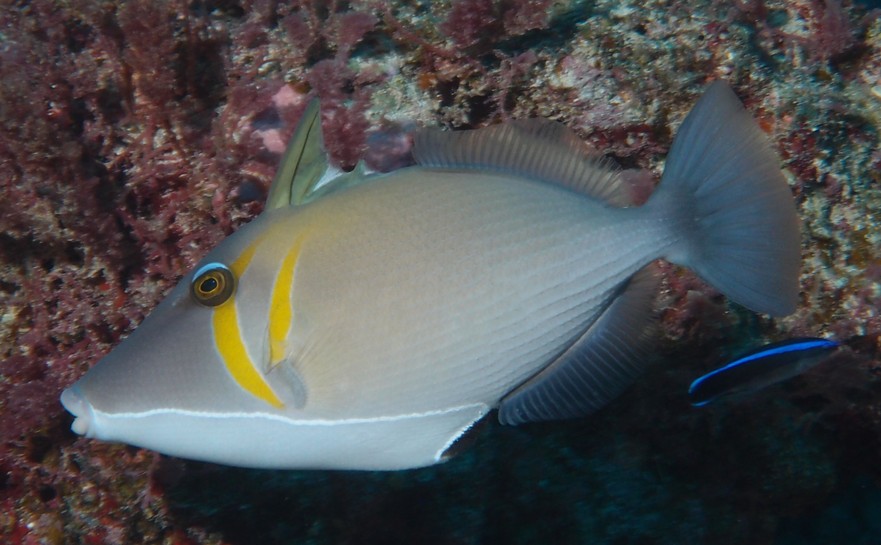SUFFLAMEN BURSA - (BLOCH & SCHNEIDER, 1801)
Actinopterygii (Gigaclass) > Actinopteri (Class) > Teleostei (Subclass) > Tetraodontiformes (Order) > Balistoidei (Suborder) > Balistidae (Family) > Sufflamen (Genus)
Baliste carène, Baliste boomerang, Baliste à lignes blanches, Boomerang triggerfish, Lei triggerfish, Whiteline triggerfish, Pallid triggerfish, Scimitar triggerfish, Scythe triggerfish, Boemerang-snellervis, Pungaftrækkerfisk, Doppelsichel-Drückerfisch, Porco de Boomerang, Pungtryckarfisk, Musumehagi, ムスメハギ, 頸帶多棘鱗魨,
Synonymes
Balistes bursa (Bloch & Schneider, 1801)
Balistes communis (Bonnaterre, 1788)
Balistes sonneratii (Shaw, 1804)
Hemibalistes bursa (Bloch & Schneider, 1801)
----------------------
Description
Dorsal spines (total): 3; Dorsal soft rays (total): 27-30; Anal soft rays: 25-27; Pectoral fin rays: 13-14. Lateral scale series: 43–50. Median part of each scale on rear part of body with small spine, sharp posteriorly and weak anteriorly, forming elevated, longitudinal ridges on body extending forward to below middle of spinous dorsal fin. Max. length: 25.0 cm TL. Depth range: 3 - 90 m.
Color
Body pale brown; Two vertical, curved, yellowish brown to greenish bands on body, anterior band from above and through eye to in front of pectoral-fin base, and posterior band from below middle of first dorsal fin to pectoral fin base; Distinct narrow blue-white line from near corner of mouth to anal-fin origin, and throat and belly below this line paler than rest of body; Ventral midline brown from pelvic-fin rudiment to some point along anal-fin base. Attains
Etymology
Sufflamen: from Latin, sufflamen = clog, impediment. Sufflamen (impediment) is a word used by Dr Samuel Latham Mitchill (1764-1831) for the "trigger" of these "Trigger Fishes." David Starr Jordan, 1916.
bursa: from the ancient Greek, búrsa = hide, wine-skin, oxhide, animal skin (by extension, Medieval Latin) purse, especially one made of skin or leather.
Original descripition: Balistes chrysopterus Bloch & Schneider, 1801 - Type locality:
Distribution
Indo-West Pacific: East Africa, South Africa, Seychelles, Comoros, Madagascar and Mascarenes (La Réunion, Mauritius, Rodrigues), east to Hawaiian Islands (U.S.A.) and Pitcairn Group, north to southern Japan and Ogasawara Islands (Japan), south to Australia, New Caledonia and Rapa (French Polynesia).
Biology
Inhabit clear inner and outer reef habitats from exposed algae reef flats to deep along drop-offs. Occur in seaward reefs below the surge zone. Benthopelagic. Feed on crabs, bivalves, gastropods, algae, echinoids, tunicates, worms, eggs, and detritus. Oviparous. Also taken by drive-in nets.
Last update: 27, March 2023
Baliste carène, Baliste boomerang, Baliste à lignes blanches, Boomerang triggerfish, Lei triggerfish, Whiteline triggerfish, Pallid triggerfish, Scimitar triggerfish, Scythe triggerfish, Boemerang-snellervis, Pungaftrækkerfisk, Doppelsichel-Drückerfisch, Porco de Boomerang, Pungtryckarfisk, Musumehagi, ムスメハギ, 頸帶多棘鱗魨,
Synonymes
Balistes bursa (Bloch & Schneider, 1801)
Balistes communis (Bonnaterre, 1788)
Balistes sonneratii (Shaw, 1804)
Hemibalistes bursa (Bloch & Schneider, 1801)
----------------------
Description
Dorsal spines (total): 3; Dorsal soft rays (total): 27-30; Anal soft rays: 25-27; Pectoral fin rays: 13-14. Lateral scale series: 43–50. Median part of each scale on rear part of body with small spine, sharp posteriorly and weak anteriorly, forming elevated, longitudinal ridges on body extending forward to below middle of spinous dorsal fin. Max. length: 25.0 cm TL. Depth range: 3 - 90 m.
Color
Body pale brown; Two vertical, curved, yellowish brown to greenish bands on body, anterior band from above and through eye to in front of pectoral-fin base, and posterior band from below middle of first dorsal fin to pectoral fin base; Distinct narrow blue-white line from near corner of mouth to anal-fin origin, and throat and belly below this line paler than rest of body; Ventral midline brown from pelvic-fin rudiment to some point along anal-fin base. Attains
Etymology
Sufflamen: from Latin, sufflamen = clog, impediment. Sufflamen (impediment) is a word used by Dr Samuel Latham Mitchill (1764-1831) for the "trigger" of these "Trigger Fishes." David Starr Jordan, 1916.
bursa: from the ancient Greek, búrsa = hide, wine-skin, oxhide, animal skin (by extension, Medieval Latin) purse, especially one made of skin or leather.
Original descripition: Balistes chrysopterus Bloch & Schneider, 1801 - Type locality:
Distribution
Indo-West Pacific: East Africa, South Africa, Seychelles, Comoros, Madagascar and Mascarenes (La Réunion, Mauritius, Rodrigues), east to Hawaiian Islands (U.S.A.) and Pitcairn Group, north to southern Japan and Ogasawara Islands (Japan), south to Australia, New Caledonia and Rapa (French Polynesia).
Biology
Inhabit clear inner and outer reef habitats from exposed algae reef flats to deep along drop-offs. Occur in seaward reefs below the surge zone. Benthopelagic. Feed on crabs, bivalves, gastropods, algae, echinoids, tunicates, worms, eggs, and detritus. Oviparous. Also taken by drive-in nets.
Last update: 27, March 2023
